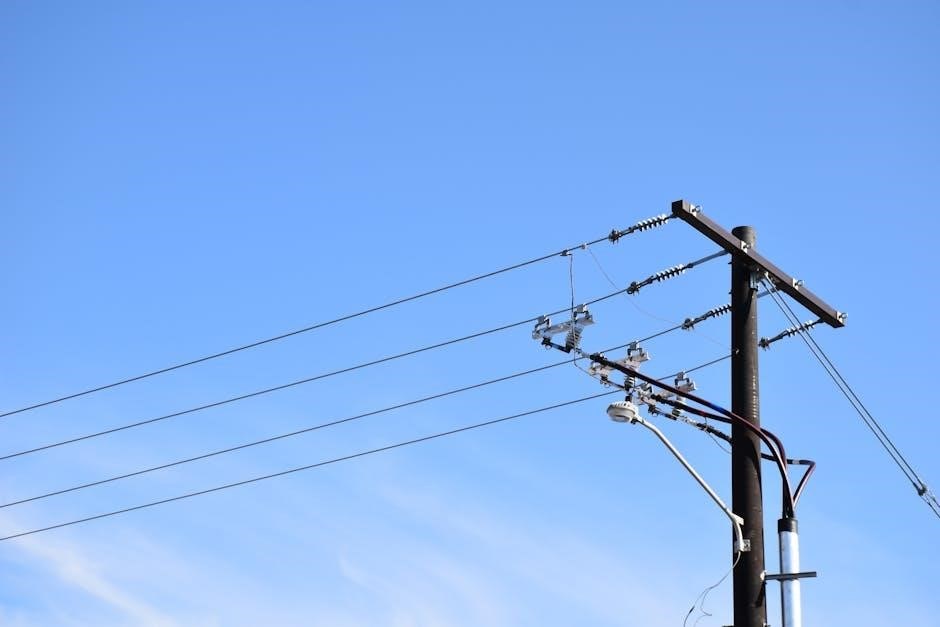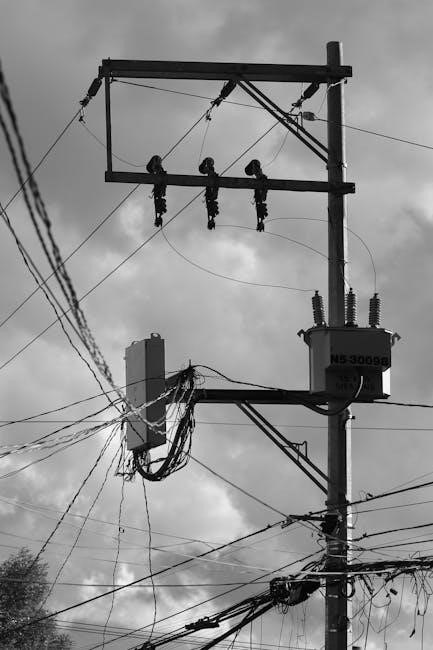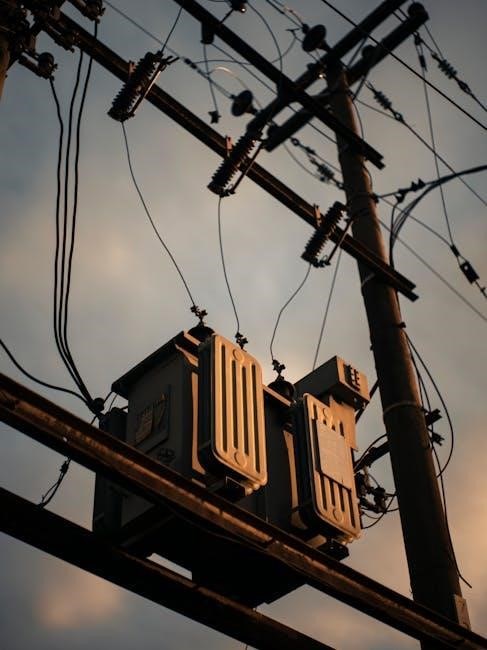Transformer wiring is a fundamental aspect of electrical systems, ensuring safe and efficient power transfer. This guide covers essential principles, wiring diagrams, and procedures for proper installation and maintenance.
1.1 Basics of Transformers
A transformer is an electrical device that transfers power between circuits through electromagnetic induction. It consists of a primary and secondary winding wrapped around a common core. Transformers can step up or step down voltages, ensuring efficient power transmission. They are categorized into single-phase and three-phase types, each serving specific applications. Proper wiring is crucial for safe and efficient operation.
1.2 Importance of Proper Wiring
Proper transformer wiring is essential for ensuring safe and efficient electrical operation. Incorrect wiring can lead to short circuits, overheating, or even system failure. Adhering to wiring diagrams and industry standards prevents hazards, ensuring reliable power transmission. Proper connections also maximize efficiency, reduce energy losses, and extend the transformer’s lifespan, making it a critical step in any electrical setup.
Understanding Transformer Wiring Diagrams
Transformer wiring diagrams are essential for safe and efficient connections. They use standardized symbols to represent components, ensuring clarity and accuracy in installation and troubleshooting processes.
2.1 How to Read Wiring Diagrams
Reading transformer wiring diagrams involves identifying symbols, understanding connections, and recognizing configurations. Start by locating the primary and secondary windings, then trace connections to ensure correct polarity and phasing. Pay attention to grounding points and safety features. Always refer to the legend for symbol meanings to avoid errors during installation or troubleshooting.
2.2 Key Components of a Transformer Wiring Diagram
A transformer wiring diagram includes essential elements like primary and secondary windings, terminals, and grounding symbols. It also shows circuit breakers, fuses, and connectors. Each component is labeled clearly to indicate its function and connection points. Understanding these elements ensures proper installation, safety, and efficient operation of the transformer in various electrical systems.
Transformer Installation Requirements
Proper transformer installation requires adherence to safety standards and guidelines. Ensure the transformer is installed by a licensed electrician, using appropriate materials and following manufacturer specifications.
3.1 Necessary Installation Guidelines
Transformer installation must follow strict guidelines to ensure safety and efficiency. Always use licensed electricians and adhere to NFPA 70E standards. Verify the load requirements and select the correct nominal power. Proper wiring diagrams and manufacturer specifications are essential. Regular maintenance and inspections are crucial to prevent faults and ensure optimal performance over time.
Selecting the correct nominal power for a transformer involves calculating total load requirements, including starting power for motors. Ensure the transformer matches primary and secondary voltage needs. Oversize by 10-20% for efficiency and future expansion. Consider environmental factors like temperature and adhere to industry standards. Always consult manufacturer specifications and seek professional advice if uncertain.
Safety Guidelines for Transformer Wiring
3.2 Choosing the Right Nominal Power
Selecting the correct nominal power ensures efficient operation and safety. Calculate total load requirements, including starting power for motors. Oversize by 10-20% for future expansion. Consider environmental factors and adhere to industry standards. Always match primary and secondary voltage ratings. Consult manufacturer specifications and seek professional advice if uncertain to avoid overload risks.
4.1 General Safety Precautions
Always de-energize the circuit before starting work. Use proper personal protective equipment (PPE) like insulated gloves and safety glasses. Follow NFPA 70E and CSA Z462 standards for electrical safety. Ensure proper insulation and avoid overloaded circuits. Keep the work area clean and well-ventilated. Never touch live wires or components. Use appropriately rated tools and ensure all connections are secure to prevent arcing or short circuits.
4.2 Personal Protective Equipment (PPE)
Wear insulated gloves, safety glasses, and a face shield when handling transformers. Use voltage-rated tools and ensure proper arc flash protection. Adhere to NFPA 70E and CSA Z462 standards for electrical safety. PPE is crucial to prevent electrical shock, arc flash injuries, and other potential hazards during transformer wiring and maintenance. Always inspect PPE before use to ensure integrity and effectiveness.
Step-by-Step Wiring Procedures
Step-by-step transformer wiring involves assessing load requirements, connecting primary and secondary windings, ensuring proper grounding, and testing connections for safety and efficiency.
5.1 Single-Phase Transformer Wiring
Single-phase transformer wiring involves connecting the primary coil to the power source and the secondary coil to the load. Start by ensuring the transformer is appropriately rated for the required voltage and current. Identify the primary and secondary terminals, typically marked or color-coded. Connect the primary winding to the incoming power supply, ensuring correct polarity. Ground the transformer for safety, usually through a designated terminal. Install protective devices like fuses or circuit breakers in the primary circuit to prevent overloads. Use a multimeter to verify the secondary voltage before connecting the load. Ensure the wiring uses the correct gauge to handle the current and avoid voltage drop or overheating. Mount the transformer securely and provide adequate ventilation. Always follow safety protocols, such as disconnecting power and wearing PPE, when working with electrical systems. Consulting a wiring diagram specific to your transformer model is recommended for accurate connections.
5.2 Three-Phase Transformer Wiring
Three-phase transformer wiring involves connecting the primary and secondary windings in either a delta or star (wye) configuration. Ensure the transformer is rated for the required voltage and current. Connect the primary terminals to the three-phase power supply, and the secondary terminals to the load. Proper grounding is essential, especially in star configurations, to prevent overvoltages. Use appropriately sized cables to handle the current, and ensure all connections are secure. Always follow the manufacturer’s wiring diagram for specific configurations, such as step-down or step-up applications. Verify the phase sequence and voltage levels before energizing the circuit. Safety precautions, like de-energizing the circuit and using PPE, are crucial during installation and maintenance.

Transformer Wiring for Specific Applications
Transformer wiring varies by application, such as power conversion (e.g., 480V to 120V) or distribution transformers. Specific configurations ensure optimal performance in industrial, commercial, or residential setups.
6.1 Wiring for Power Conversion (e.g., 480V to 120V)
Wiring for power conversion, such as 480V to 120V, requires precise connections to ensure safe and efficient voltage transformation. This process is critical in industrial and commercial settings, where step-down transformers are commonly used. Proper wiring involves connecting primary coils to the 480V supply and secondary coils to the 120V load, adhering to safety standards and manufacturer guidelines to prevent overloading or short circuits.
6.2 Wiring for Distribution Transformers
Wiring distribution transformers involves connecting them to power distribution systems, ensuring efficient energy delivery. These transformers step down high voltage to safer, usable levels for consumers. Proper wiring ensures reliable power supply, adhering to safety guidelines and load requirements. Correct connections prevent overloading and short circuits, maintaining system integrity and efficiency in residential or industrial settings.

Troubleshooting Common Wiring Issues
Troubleshooting transformer wiring involves identifying faults such as short circuits, overloading, or incorrect connections. Regular inspections and using tools like multimeters can help resolve these issues efficiently.
7.1 Identifying Faults in Transformer Wiring
Identifying faults in transformer wiring involves checking for short circuits, overloading, or incorrect connections. Use tools like multimeters to measure voltage and current. Inspect wires for damage or loose connections. Ensure polarity matches the wiring diagram. Adhere to safety standards like NFPA 70E to avoid risks during troubleshooting. Regular maintenance helps prevent major issues.
7.2 Repairing and Maintaining Transformer Wiring
Repairing transformer wiring requires replacing damaged components and ensuring secure connections. Always use appropriate PPE and follow standards like NFPA 70E. Check for short circuits, loose wires, and overloading. Use multimeters to verify voltage and current. Regular maintenance, such as inspecting insulation and tightening connections, prevents faults. Refer to manufacturer manuals for specific repair guidelines to ensure safety and efficiency.
Tools and Materials Needed
Essential tools include multimeters, wire strippers, screwdrivers, and crimpers. Use high-quality cables, connectors, and insulation materials to ensure safe and efficient transformer wiring. Always follow industry standards.
8.1 Essential Tools for Transformer Wiring
Multimeters, wire strippers, screwdrivers, and crimpers are essential tools for transformer wiring. Use high-quality cables, connectors, and insulation materials. Ensure proper PPE, including gloves and safety glasses. A wire gauge chart and torque wrench may also be necessary. Always refer to the wiring diagram for specific requirements to ensure safe and efficient installation.
8.2 Recommended Materials for Safe and Efficient Wiring
Use high-quality cables with appropriate voltage ratings and insulation. Ensure connectors are compatible with transformer terminals. Heat-resistant materials and weatherproof coatings are essential for outdoor installations. Terminal lugs and cable ties secure connections. Always select materials that meet industry standards to prevent overheating and short circuits, ensuring long-term reliability and safety in transformer wiring applications.

Best Practices for Transformer Wiring
Always follow industry safety standards and use high-quality materials. Ensure proper insulation and secure connections to prevent failures. Regularly inspect and maintain wiring for optimal performance and longevity.
9.1 Adherence to Industry Standards
Adhering to industry standards is crucial for safe and efficient transformer wiring. Always follow regulations like NFPA 70E and CSA Z462 for electrical safety. Use materials and methods compliant with IEEE and UL standards. Proper documentation and adherence to these guidelines ensure reliability, reduce risks, and meet legal requirements. Compliance also prevents potential hazards and ensures system longevity.
9.2 Ensuring Efficiency and Safety
Efficiency and safety are paramount in transformer wiring. Always use proper materials and follow best practices to minimize energy loss. Regular inspections and maintenance ensure optimal performance. Proper load calculation and grounding prevent overheating and hazards. Use personal protective equipment (PPE) during installation and repairs. Adherence to safety standards ensures reliable operation and protects against potential risks.
Common Mistakes to Avoid
Common mistakes in transformer wiring include improper connections, incorrect polarity, and ignoring load requirements. These errors can lead to overheating, short circuits, and safety risks.
10.1 Avoiding Improper Connections
Improper connections are a leading cause of transformer failures. Always follow the wiring diagram and ensure terminals are securely connected. Misaligning phases or reversing polarity can cause malfunctions. Use appropriate tools to tighten connections and verify wire sizes match the load requirements. Double-checking connections before energizing the system is crucial for safety and reliability.
10.2 Preventing Overloading and Short Circuits
Overloading and short circuits are critical issues that can damage transformers and pose safety risks. Always calculate load requirements accurately and use wires sized appropriately for the current. Avoid overloading by ensuring the transformer’s capacity matches the connected devices. Install circuit breakers or fuses to protect against short circuits. Regularly inspect wires for damage and adhere to safety standards to prevent such hazards.
Transformer Wiring Diagrams and Schematics
Transformer wiring diagrams and schematics are essential for safe and efficient installation. They provide detailed visual representations of connections, ensuring proper configuration and compliance with electrical standards.
11.1 Types of Transformer Wiring Diagrams
Transformer wiring diagrams vary based on application and configuration. Common types include single-phase, three-phase, step-down, and step-up diagrams. Each diagram illustrates specific connections for primary and secondary windings, ensuring safe and efficient power transfer. They also detail grounding, shielding, and terminal connections. These visual guides are essential for electricians to install and maintain transformers accurately, adhering to safety standards and system requirements.
11.2 Interpreting Schematic Symbols
Understanding schematic symbols is crucial for interpreting transformer wiring diagrams. Common symbols include coils, terminals, and grounding points. Standardized symbols, such as those from IEEE, ensure consistency. Familiarity with these symbols helps technicians identify primary and secondary windings, phase connections, and safety components. Accurate interpretation ensures proper wiring, preventing errors and enhancing safety. This skill is vital for efficient and reliable transformer installations.

Additional Resources and References
Consult IEEE standards, manufacturer manuals, and online guides for detailed transformer wiring practices. Resources like Maddox and HPS guides offer practical insights and diagrams for safe installations. Additionally, design guides for transformer connections provide in-depth technical specifications and troubleshooting tips, ensuring compliance with industry standards and enhancing wiring efficiency and safety.
12.1 Recommended Guides and Manuals
Key resources include IEEE C57.105-2019 for transformer connections and NFPA 70E for safety. Manufacturer manuals, like Maddox guides, provide specific wiring details. HPS resources offer troubleshooting tips, while design guides cover technical specifications. These materials ensure compliance with industry standards and enhance wiring efficiency and safety.
12.2 Online Tools for Transformer Wiring
Utilize online tools like interactive wiring diagrams and simulation software for precise configurations. Manufacturer websites, such as Acme Electric, provide detailed diagrams and technical specifications. IEEE standards and design guides are accessible online, offering in-depth guidance. Forums and technical support resources from companies like HPS and Maddox also aid in troubleshooting and optimal wiring solutions.
Proper transformer wiring ensures safety and efficiency. Always follow guidelines and best practices for optimal results. Safe wiring practices are crucial for reliable electrical systems.
13.1 Summary of Key Points
Understanding transformer wiring is crucial for safe and efficient electrical systems. Key points include proper wiring techniques, adherence to safety guidelines, and using accurate diagrams. Regular maintenance ensures optimal performance. Always follow industry standards and consult professionals for complex installations. Proper transformer wiring enhances reliability and minimizes risks in both residential and industrial applications.
13.2 Final Tips for Successful Transformer Wiring
Always adhere to manufacturer guidelines and industry standards. Double-check connections before powering up. Use appropriate tools and test equipment to ensure accuracy. Consult professionals for complex configurations. Proper documentation and labeling are essential. Regularly inspect and maintain wiring for longevity. Prioritize safety and efficiency in every step of the process.



